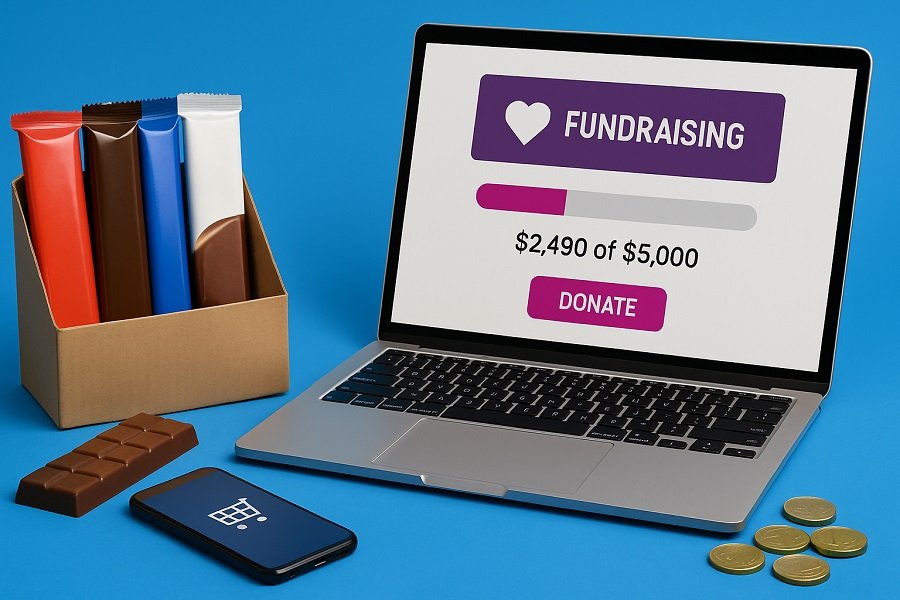In today’s fundraising environment, schools face increasing pressure to reach financial goals while balancing limited time, volunteer support, and student participation. Traditional campaigns like candy bar fundraisers remain popular due to their simplicity and universal appeal, but they’re no longer limited to in-person selling. As online fundraising continues to evolve, combining these two methods has become an effective way for schools to maximize participation and revenue.
This article explores how schools can boost candy bar sales through digital fundraising tools, what tradeoffs to consider, and the challenges that may arise. Whether you’re a PTA leader, school administrator, or volunteer parent, this guide provides the insights you need to make strategic choices that fit your school community.
The Appeal of Candy Bar Fundraisers
There’s a reason candy bar fundraisers continue to be a go-to option for schools. The product is affordable, easy to sell, and appeals to a wide audience. Students enjoy participating because it’s fun and tangible, while supporters often find it more rewarding than purely donation-based efforts.
However, one key challenge remains: the reach of in-person selling is limited. Most sales are confined to neighborhoods, family, and friends. That’s where integrating digital tools becomes important.
The Role of Online Fundraising in Traditional Campaigns
Online fundraising, when used alongside traditional campaigns, can dramatically increase visibility and participation. Schools are increasingly using digital tools not only for donation campaigns but also to manage and promote product-based drives. In the context of candy bar fundraisers, this might mean setting up web pages for ordering, enabling cashless payments, and tracking student progress through digital dashboards.
The inclusion of even basic virtual fundraising features—such as QR codes on packaging or links to school-branded ordering pages—can help supporters engage from anywhere. It also allows schools to reach out to alumni, remote family members, and community supporters beyond local boundaries.
Why Go Digital? Key Benefits for Schools
1. Greater Reach
Digital platforms allow fundraising campaigns to reach beyond local communities. Relatives in other states or even countries can support the fundraiser without being physically present. This added accessibility can boost participation, especially for larger schools with widespread networks.
2. Streamlined Coordination
Using a platform to manage your candy fundraiser ideas simplifies coordination for school staff and volunteers. Tools can automate tasks like tracking orders, calculating totals, sending reminders, and generating thank-you messages. For schools short on volunteer manpower, this can be a significant advantage.
3. Improved Safety and Convenience
Cashless transactions reduce the need for students to carry money and minimize handling errors. With digital payments, schools lower the risk of misplaced funds and avoid reconciliation issues. This is particularly valuable in a time when many parents prefer contactless solutions.
4. Better Reporting and Transparency
Virtual fundraising platforms typically include built-in analytics. Schools can track sales in real time, compare participation between classrooms, and see which outreach methods work best. These insights support data-driven decisions for future campaigns.
Tools That Help Schools Go Digital
There’s no shortage of platforms available, ranging from general crowdfunding tools to those tailored specifically for school fundraising. Some popular features include:
Personalized student or classroom fundraising pages
Social sharing buttons (Facebook, Instagram, email)
Mobile payment compatibility (Apple Pay, Google Pay)
Digital incentive tracking for prize-based campaigns
Order fulfillment tracking and direct-to-home shipping
Some platforms even integrate with school communication systems, allowing for announcements and progress updates within existing parent-teacher networks.
The best choice for your school depends on the scale of the campaign, available volunteer time, and the tech-savviness of your community.
Tradeoffs and Considerations
While digital tools bring clear benefits, they also introduce tradeoffs. Not all families are equally comfortable with technology, and not every school has the same infrastructure or resources to implement new tools. Here are a few considerations when blending digital and candy fundraising efforts:
Accessibility vs. Complexity
Adding a digital layer can increase reach but may also overwhelm parents or volunteers unfamiliar with the process. Choosing user-friendly tools with simple interfaces is key. It’s also important to offer alternatives for families who prefer in-person options.
Convenience vs. Cost
Many digital platforms charge service or transaction fees. While these may be small percentages per order, they can eat into overall profits if not accounted for. Schools must balance the convenience of automation with the financial impact of these added costs.
Promotion vs. Oversaturation
Running both in-person and virtual campaigns requires careful planning to avoid donor fatigue. If families are bombarded with multiple messages across different channels, they may tune out. A centralized communication plan helps maintain clarity.
Overcoming Common Challenges
1. Getting Buy-In from Stakeholders
Not all teachers, parents, or administrators may be eager to adopt a hybrid approach. Start by sharing data from similar schools or pilot programs showing the benefits of combining digital fundraising with candy fundraiser ideas. Hosting a short training session or walkthrough of the tools can also ease concerns.
2. Technical Barriers
If your school community includes families without easy internet access or comfort with digital tools, provide low-tech options alongside your digital campaign. Printable flyers with QR codes, phone-in orders, or order forms dropped off at school can serve as bridges.
3. Maintaining Engagement
Digital platforms are not magic wands. You’ll still need creative engagement strategies to keep students and supporters excited. Consider leaderboards, weekly shoutouts, or themed challenges to keep momentum going. Integrate the digital experience with real-world incentives and school pride.
Strategies to Drive Digital Participation
Once a digital component is introduced, promoting it effectively becomes just as important as the candy itself. Here are a few tactics that work well:
Student-Led Videos: Short clips of students explaining the campaign can create emotional connection and encourage sharing.
Parent Ambassadors: Recruit a few engaged parents to champion the fundraiser on social media and within class groups.
Email Templates: Provide families with ready-made messages they can copy and paste to friends and family.
Branded Visuals: Use eye-catching graphics featuring your school mascot or colors to draw attention to the fundraiser.
Incentive Milestones: Create reward levels that are trackable online and posted weekly to build anticipation.
Measuring Success Beyond Profits
While the bottom line is important, success should also be measured by participation rates, satisfaction, and community engagement. A smaller profit from a well-loved campaign may be more sustainable long-term than a large haul with minimal enthusiasm.
Collect feedback after each campaign using short surveys. Ask families what worked, what confused them, and whether they’d participate again. This feedback loop helps schools refine future efforts and create better experiences year after year.
Making the Transition: A Phased Approach
For schools new to digital fundraising, diving into a fully online campaign may feel risky. A phased rollout offers a gentler entry. Here’s how:
Phase One: Augment, Don’t Replace
Start by offering online payment options alongside traditional sales. Use digital tools for tracking, while still distributing physical candy bars at school.Phase Two: Introduce Online Promotion
Create a basic landing page and encourage families to share it. Add a social media push but keep physical order forms as a backup.Phase Three: Go Hybrid
Shift to a fully managed hybrid campaign where digital platforms handle tracking, communication, and orders—while still using face-to-face selling for hands-on engagement.Phase Four: Evaluate and Expand
Assess results, document learnings, and decide whether to lean more heavily into virtual fundraising or keep a balanced model.
Real-World Example: A Middle School Success Story
At Greenhill Middle School, the PTA ran a candy fundraiser with modest goals, expecting most sales to come through in-person efforts. A week in, they created a school-branded fundraising page using a digital tool that allowed each student to share a personalized link. QR codes were included in physical flyers sent home.
By the end of the campaign, 40% of sales had come from outside the local area—family and friends who likely wouldn’t have contributed otherwise. Volunteers reported easier reconciliation, and the school saw a 30% increase in participation compared to the previous year.
This success was attributed to smart integration, clear instructions, and the appeal of familiar products combined with digital convenience.
Final Thoughts: Choosing What’s Right for Your School
The decision to combine digital fundraising with candy fundraiser ideas isn’t one-size-fits-all. It involves balancing accessibility, cost, engagement, and technology adoption. Each school community is unique—what works in a suburban district with high internet access may not be practical for a small rural school.
That said, the tools now exist to make these campaigns more inclusive, more efficient, and potentially more profitable. By carefully selecting platforms, planning communication, and involving the school community, schools can modernize their approach to candy fundraising without losing the charm that made these campaigns popular in the first place.
As schools continue to adapt to new challenges in funding extracurriculars, supplies, and events, the integration of virtual fundraising strategies offers not just a solution—but an opportunity.







